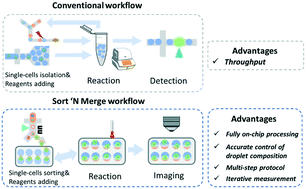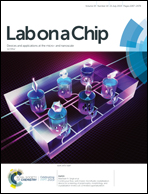Single-cell RT-LAMP mRNA detection by integrated droplet sorting and merging†
Abstract
Recent advances in transcriptomic analysis at single-cell resolution reveal cell-to-cell heterogeneity in a biological sample with unprecedented resolution. Partitioning single cells in individual micro-droplets and harvesting each cell's mRNA molecules for next-generation sequencing has proven to be an effective method for profiling transcriptomes from a large number of cells at high throughput. However, the assays to recover the full transcriptomes are time-consuming in sample preparation and require expensive reagents and sequencing cost. Many biomedical applications, such as pathogen detection, prefer highly sensitive, reliable and low-cost detection of selected genes. Here, we present a droplet-based microfluidic platform that permits seamless on-chip droplet sorting and merging, which enables completing multi-step reaction assays within a short time. By sequentially adding lysis buffers and reactant mixtures to micro-droplet reactors, we developed a novel workflow of single-cell reverse transcription loop-mediated-isothermal amplification (scRT-LAMP) to quantify specific mRNA expression levels in different cell types within one hour. Including single cell encapsulation, sorting, lysing, reactant addition, and quantitative mRNA detection, the fully on-chip workflow provides a rapid, robust, and high-throughput experimental approach for a wide variety of biomedical studies.

- This article is part of the themed collection: Single Cell Analysis


 Please wait while we load your content...
Please wait while we load your content...